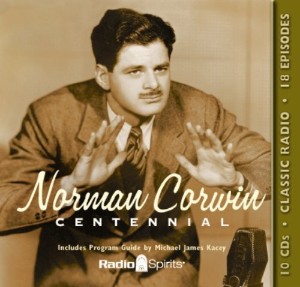The Plot to Overthrow Christmas (Spiknutí proti Vánocům, 1938, 1940, 1944, 2010)
 Norman Corwin. Rozhlasová hra.
Norman Corwin. Rozhlasová hra.
Nastudoval CBS Radio Network v roce 1938. Premiéra 25. 12. 1938. Repríza 22. 12. 1940, 19. 12. 1944.
Vyšlo 2010 v kompletu Norman Corwin Radio Spirits Box Set – The Centennial Collection.
K poslechu zde. Nastudování z roku 1944 k poslechu zde.
Pozn.: V nastudování z roku 1940 účinkuje Eric Burroughs.
Lit.: Barrett, Donald: The Plot to Overthrow Christmas. In web Youtube, 2015 (komentář). – Cit.: I received an email from a commenter on this project. He mentioned that my uncle wrote a score for an animated feature based on Norman Corwin’s „The Plot to Overthrow Christmas“. Actually, Walter it was an opera, and on several occasions played the music from a piano score score while he sang all the parts. He was a marvelous composer and musician, but hardly an operatic soprano. The opera, sadly, was never produced and with his death is probably no consigned to history.
Lit.: anonym: The Plot to Overthrow Christmas. In web Wikipedia, the free encyclopedia, b. d. (článek). – Cit.: The Plot to Overthrow Christmas is a radio play written by Norman Corwin and first performed on December 25, 1938.
Plot
The play, a fantasy told entirely in rhyme, begins with a narrative introduction. It proceeds without further narration, but a character named Sotto voce occasionally interrupts with parenthetical footnotes for the audience. Sound effects depict a descent to Hell: a gong, followed by two crashes of thunder; then an electronic hum, first descending, then ascending in pitch; which dissolves into a sustained violin note, which finally turns into a classical cadenza.
The violin is being played by the Roman emperor Nero, whose playing is interrupted by a courier summoning him to an urgent meeting called by the Devil, Mephistopheles. Mephisto explains to an assembly including Nero, Ivan the Terrible, the Biblical Haman, the Roman emperor Caligula, the Borgias, and Simon Legree, that he is concerned about the thwarting of his efforts to corrupt humanity, by the peace and good will generated by the Christmas holiday. He solicits proposals to deal with the matter. First, Caligula suggests poisoning Christmas foods and candies. Next, Nero suggests corrupting sacred Christmas music by converting it to jazz style, as has been done to classical music. Then Legree suggests bribing the US Congress to outlaw Christmas, but Mephisto points out the uncertainty of depending on corrupt politicians, who could just as easily be turned the other way. Finally, Lucrezia Borgia suggests assassinating Santa Claus, a deed she is anxious to do herself. Mephisto puts the proposals to a vote, and Borgia’s plan wins. Nero is then chosen by lottery as the assassin.
After a bit of fuss about how to get to Earth and to find Santa, Nero ascends to Earth with a gun in Act II and makes the arduous trek to Santa’s domicile in the North Pole. Santa invites him in, well aware of Nero’s sinister purpose. Santa tells Nero that the Devil cares nothing about Nero, and is only using him to acquire as large an earthly empire as possible. Nero briefly succumbs to this logic, but then takes Santa’s argument as a battle of wits, and boasts of his intellectual superiority and cultural (musical) sensitivity. Santa counters Nero’s boasting by expounding on the sentimental joys and wonders of Christmas, of which Nero knows nothing. This touches Nero’s heart and causes him to repent of his evil purpose and ask how he can help Santa. Santa then showers Nero with hospitality, and runs to get a present for him: a Stradivarius violin. Santa also gives him a piece of sheet music, and the play closes with Nero playing The First Noel on the Stradivarius.
Conception and early productions
In 1938, Norman Corwin was hired by the CBS Radio Network and given his own show, Norman Corwin’s Words Without Music. After the show on the week before Christmas, his producer put him on the spot by asking him what he intended to do for a Christmas show. Corwin came up with the title off the top of his head. This constrained his writing, but gave him the opening line: „Did you hear about the plot to overthrow Christmas?“ The play was first broadcast on December 25. By 1940, Corwin was leading CBS’s Columbia Workshop, and he again produced The Plot to Overthrow Christmas on December 22 of that year. CBS had Corwin produce and direct the play a third time on December 19, 1944, with most of the original cast, which included Will Geer as Mephistopheles. Santa Claus was played by House Jameson, and Nero was played by black stage and radio actor Eric Burroughs. Henry Morgan appeared in the 1944 broadcast as the narrator, as Ivan the Terrible, and Simon Legree.[1] Corwin called Burroughs „the finest Negro actor in radio“ after his 1936 appearance in Orson Welles‘ Federal Theatre production of Macbeth. Jameson later appeared in supporting roles in the 1948 film The Naked City and in nine episodes of its television series adaptation between 1959 and 1963.
In 1960, Corwin collaborated with composer Walter Scharf to turn the play into an opera, for which he provided the libretto. However, Corwin and Scharf could not agree on business terms, and the opera remained only in manuscript form. It was performed only once, in 2000 at Brigham Young University.
Recreation on public television
In 1969, Los Angeles public television station KCET produced a program about Corwin’s play, which included an interview with Corwin about the play’s origin, and a rehearsal and television reading of the play. The show was rebroadcast on PBS on December 23, 1971, as an episode of Hollywood Television Theatre. KCET rebroadcast the program in 2010 (about a year before Corwin’s death) in honor of his 100th birthday, and followed it with a new interview with Corwin.
Corwin added two scenes to his original script for the TV production. On his way to the North Pole, Nero encounters a reporter who attempts to poll him on his opinions of classical composers and conductors. He also briefly encounters a woman speaking a strange-sounding language; Corwin decided to add this after hearing an extra cast as one of the demons imitate the sound of a tape being rewound.
Cast
Corwin cast several contemporary veteran radio and television character actors for his 1969 television production.
John McIntire as the Devil; McIntire was a character actor known from his starring role in the television series Wagon Train from 1961 to 1965.
Karl Swenson as Nero; Swenson was a veteran film and television character actor, best known as Lars Hanson from 1974 to 1978 on television’s Little House on the Prairie.
Jeanette Nolan as Lucrezia Borgia; Nolan, a radio, film and television actress, was the wife of McIntire.
Parley Baer as Simon Legree; Baer was a radio and television character actor known as the next-door neighbor on The Adventures of Ozzie and Harriet and as the mayor of Mayberry on The Andy Griffith Show.
Edward Platt as Sotto Voce; Platt was known as Maxwell Smart’s boss on the 1960s TV series Get Smart.
Alan Reed, Sr. as Santa Claus; Reed was famous as the original voice of Fred Flintstone in the 1960s TV series The Flintstones.
Jerry Hausner as the courier; Hausner appeared on I Love Lucy as the agent of Ricky Ricardo (Desi Arnaz), and as the voice of cartoon character Mr. Magoo’s nephew Waldo.
Paul Condylis as Haman and the Announcer. He played roles in „What’s Up, Doc?“, and „Targets“.
Henry Corden as Ivan the Terrible; Corden was best known for taking over the voice of Fred Flintstone when Reed died in 1977.
Byron Kane as the Reporter; made 43 appearances on TV shows and movies.[citation needed]
Steve Franken as Caligula; Franken appeared numerous times on TV and film.
Lit.: Truesdale, Dave: The Plot to Overthrow Christmas – Norman Corwin. In web Tangent Online, 13. 12. 2009 (článek). – Cit.: “The Plot to Overthrow Christmas” first aired on December 25, 1938. It was written by the legendary Norman Corwin and is told entirely in rhyming verse. It is a veritable tour de force in its dark, rather ghastly depiction of demons, devils, and nefarious historical figures assigned to Hell who plot to destroy one of Christianity’s holiest celebrations. It was Corwin’s first original play on network radio after CBS hired him in 1938, and ran as the first episode of Norman Corwin’s Words Without Music.
Norman Corwin–along with Arch Oboler and Orson Welles–was, in the 1930’s and 1940’s, one of old time radio’s most respected figures. Like Oboler and Welles, Corwin wrote, produced, and directed in many genres, most notably history, fantasy, drama, and biography, often infusing his work with a social conscience. His work has influenced the likes of Rod Serling, Gene Roddenberry, and J. Michael Straczynski. Among his numerous awards, Corwin has been honored with a Golden Globe, an Emmy, and two Peabody Medals. He was voted into the Radio Hall of Fame in 1993, and a Short Feature documentary on his life (A Note of Triumph: The Golden Age of Norman Corwin) won an Oscar in 2006.
Ray Bradbury has acknowledged that Corwin was responsible for the eventual publication of The Martian Chronicles, and has said of Corwin that he is “…the greatest director, the greatest writer and the greatest producer in the history of radio.” And the late film director Robert Altman forthrightly proclaimed that “Norman Corwin was my idol.”
Listening to the clever, witty, rhyming throughout “The Plot to Overthrow Christmas,” one immediately thinks of the work of Theodor Seuss Geisel (Dr. Seuss: 1904-1991). Seuss, born in 1904 and six years’ Corwin’s senior, published and illustrated his first children’s book in 1937 (And to Think That I Saw It on Mulberry Street), a mere year before Corwin’s own entirely rhymed classic hit the airwaves. Seuss was born in Springfield, Massachusetts, and Corwin in Boston. Seuss was 33 when “Mulberry” saw print, and Corwin was 28 when he wrote “Plot.” While both Seuss and Corwin would go on to produce timeless works–and in their own fields the term genius is equally apt–one can’t help but wonder if Corwin was influenced by Seuss, his home-state contemporary whose just-published first work, it is reasonable to assume, he had opportunity to read.
Norman Lewis Corwin (May 3, 1910- ) pictured above in 1941, is still active writing for radio and various publications, and remains listed as a writer in residence at the Journalism School at the University of Southern California.
To tempt with but a taste of what you will hear, and given the political activism of some regarding Christmas today and what they perceive as the separation of church and state, here are a few lines from “The Plot to Overthrow Christmas,” where those assembled in Hell offer their ideas on how to get rid of Christmas. I find the following wry bit of observation somehow eerily prescient:
I think Mr. Nero’s made a wrong guess,
Now the way to go about it is to get in Congress.
Bribe a bunch of senators who know their oats,
And just make a practice of a bloc of votes.
And then they can legislate a situation,
Where they’ll rule old Christmas right out of the nation.
They can all get together and pass a law,
Where they ain’t gonna be no Christmas no more!
Norman Corwin’s homepage, full of fascinating information, wisdom, accolades from famous actors, writers, directors, news personalities, and historical factoids, can be found here. I urge you to visit this wonderful website and introduce yourself–if you haven’t already–to the works of a truly American „treasure.“ A measure of the influence Norman Corwin has had over his lengthy and distinguished career can be found in the hour-long radio broadcast from December 15, 1941, eight days following the bombing of Pearl Harbor. Titled „We Hold these Truths,“ it was commissioned by President Franklin Delano Roosevelt. From the Norman Corwin website:
December 15, 1941 — Norman Corwin’s „We Hold These Truths“
„Commissioned by FDR to commemorate the 150th anniversary of the Bill of Rights, this hour-long program was aired over the combined national networks (CBS, NBC Red, NBC Blue, and Mutual) eight days after Pearl Harbor. The Crosley Rating Service estimated 63 million people listened, half the US population at the time, and this was the largest audience in recorded history for a dramatic performance.“
Pictured here is Corwin discussing „We Hold These Truths“ with actor James Stewart, 1941.
Herewith, the CBS radio network’s December 19, 1944 re-dramatization of Norman Corwin’s classic “The Plot to Overthrow Christmas.” Corwin returns to produce and direct, as do most of the original cast to reprise their roles from the original 1938 production–including Will Geer (who would later star on tv’s The Waltons.)
If you enjoyed this post, please consider to leave a comment or subscribe to the feed and get future articles delivered to your feed reader.






Komentáře
Zatím nemáte žádné komentáře.
Napište komentář k článku